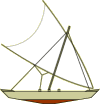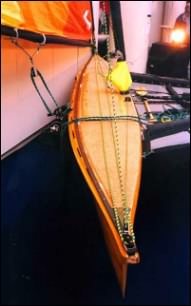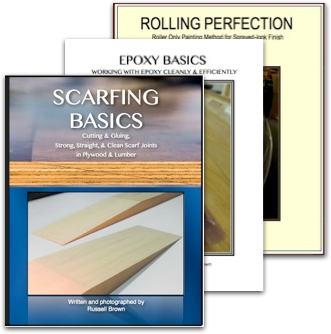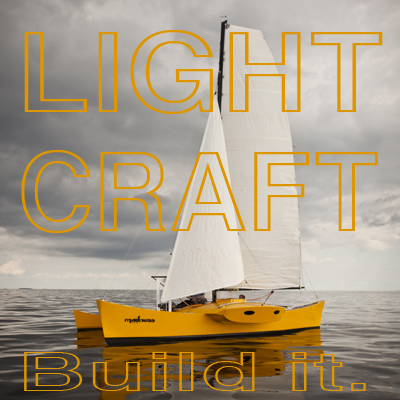Proa Rig Options: Crab Claw
GALLERY | Click images to enlarge
An overview of the potentials and problems of the remarkable rig of the native Pacific proa.

The Traditional Oceanic sprit rig (aka crab claw) has, in Western eyes, been considered a romantic if not particularly effective rig that most likely compared to the Mediterranean lateen in aerodynamic performance. That is, until famed sailboat aerodynamics researcher C. A. Marchaj published this startling graph in his research paper Planform Effect of a Number of Rigs on Sail Power.
Marchaj, under a grant from the Overseas Development Administration of the United Kingdom, tested the efficiency and power of various traditional rig types utilizing models in a wind tunnel.
Even more startling is the extraordinary performance of the crab claw sail, which demonstrates its superiority to a Bermuda mainsail right from the close-hauled condition. Its superiority increases when the boat bears away, and on reaching, with the heading angle 90 degrees, the driving force coefficient of the crab claw is about 1.7, whereas that of the Bermuda rig is about 0.9. That is, the crab claw rig delivers about 90% more driving power than the Bermuda rig.
~ Sail Performance
 Marchaj theorized that the crab claw develops lift in a different way than the standard Western Bermudan. It operates in what is called *vortex lift* mode, which creates powerful spinning tornadoes of air off the leading edge. The spinning vortexes are zones of intense low pressure, and thus lift is created. It is beyond the scope of this article go into the details of crab claw sail aerodynamics, but if you wish to learn more, Marchaj’ book Sail Performance (Adlard Coles Nautical 1996) is highly recommended.
Marchaj theorized that the crab claw develops lift in a different way than the standard Western Bermudan. It operates in what is called *vortex lift* mode, which creates powerful spinning tornadoes of air off the leading edge. The spinning vortexes are zones of intense low pressure, and thus lift is created. It is beyond the scope of this article go into the details of crab claw sail aerodynamics, but if you wish to learn more, Marchaj’ book Sail Performance (Adlard Coles Nautical 1996) is highly recommended.
Marchaj’s paper was very much an "Emperor Has No Clothes" sort of wake up call to those who believe the modern Bermuda rig is the epitome of aerodynamic progress. His tests showed that the crab claw was not the only traditional rig that could outperform the Bermudan on some courses. A lateen was superior to windward, and the gunter, sprit, and lugsail were all superior overall to the Bermudan.
The above notwithstanding, the Bermudan with a small jib tested very well close-hauled, second only to a lateen in Lift to Drag (L/D) ratio. The modern sport of yacht racing has developed around the triangular race course, a course that highly favors windward sailing efficiency. It is little wonder then that the rig most favored is one that is at its best to windward. The Bermudan tested very poorly on off wind courses however, and that fact is born out by racers needing to carry all manner of off-wind sails to augment the performance of the basic windward rig. It has also been pointed out that very fast sailboats, such as racing multihulls or ice boats, create so much apparent wind that they are always sailing close-hauled, and therefore, it’s the L/D ratio that really counts, not the max Lift Coefficient.
Crab Claw Potential
The crab claw has the potential to become a desirable cruising rig for many types of sailboat, not just proas. The rig has these potential benefits:
- Low stress rigging. This leads to cost savings, safety, and robustness.
- High performance. The crab claw has amazing power on off-wind courses, without the need for auxiliary headsails. This means the cruising sailor need no longer choose between power and ease of handling. In other words, you can remove all the expensive spinnakers, screachers, etc., and enjoy its remarkable off wind power.
- Ease of operation. The crab claw rig does not exhibit the sudden fall-off of lift, known as a stall, that the Bermudan rig does. On the contrary, it continues to pull even harder at large angles of attack. This means that the sail is more forgiving of widely varying angles of attack, and is easier to trim. All good things for the cruising sailor.
- Low center of effort. The crab claw has a very low CE and a low heeling moment, which means that any boat fitted with such a rig would enjoy enhanced stability, and would also experience reduced pitch-poling tendencies.
- Adjustable height of CE. The crab claw can be oriented in different ways simply by adjusting the halyard. The rig may be tilted straight up in light air to reach for the better breeze aloft, or in a fresh breeze it may be angled way down, to keep the CE as low as possible, and to apply the power in the safest, most manageable way.
- Low Cost. Low stress rigging, no headsails or extra downwind sails all lead to a cheap rig. The crab claw suits the do-it-yourselfer, and people on tight budgets.
Areas for Improvement
Promising as the rig is, there are certainly areas that could use study and further development.
Close-hauled ability
The crab claw is inferior to the Bermudan, no doubt. Not by much, but enough so that in a mainly windward race such as a triangular race course, the Bermudan would win. I am not aware of any modern attempts to improve the crab claw’s weatherliness, but I am sure that such an effort would lead to considerable gains. Consider the ‘claw to be at the equivalent development point of the first Windsurfer rig, in the 1960’s. It appears that there is actually a good deal of room for development, and study of the rig indicates that there are three main areas open for improvement: sharp leading edges, reduction in parasitic drag, and the specific shape of the sailplan.
The shape of the sail can benefit from a careful study of the interaction of the hull and the boom vortex, with an eye to optimizing flow of air past the boom. Proper amounts of designed- in sail twist are important and will cut drag further. Parasitic drag can be tackled in much the same manner as it is on modern wing- mast sloops, using a streamlined mast that is angled for least drag on each tack, taking care with the design of halyard placement, rigging attachments and the like to smooth the airflow.
The most promising area is in the application of sharp leading edges. Where the crab-claw with round or oval spars will show a maximum L/D ratio of around 8/1, NACA wind-tunnel testing of sharp-leading edge delta wings of similar aspect ratio show ratios around 13/1, a 62% improvement. Happily, this improvement in L/D does not come at the expense of power. Marchaj’s wind tunnel tests with a round-spar crab-claw, mounted on a representative hull, gave a whole-boat L/D of about 4/1. This argues persuasively that an improved claw-equipped proa should show a L/D at least as high as 5.5/1, and potentially even as high as 6.5/1, which puts it right up there with rotating-mast, full-battened sloops- all while retaining its high power. So the saga of the crab claw is not over by any means, and a little low-cost R&D could pay off with a very fast boat.
- John Dalziel
Reefing
Pacific Islanders apparently never reefed. There are no reef points in traditional Oceanic lateen sails. Instead, the Oceanic sailors developed a system of brails or "spilling lines". These are two lines that are tied on about 3/4th of the way out along the boom. They are then run on each side of the sail through deadeyes or blocks located on the mast top, and then down to deck, where they are either hand-held or cleated, depending on wind conditions. These lines serve several purposes;
- They act as a topping lift.
- They function like lazyjacks to keep the yard and sailcloth under control when hoisting or lowering the yard.
- They allow the sail to be de-powered or quickly furled by lifting the boom up close to the yard.
- By manipulating the lines individually, huge changes in sail drive can be had without any reduction in sail area.
- If the leeward brail is tightened, it produces a "crease" in the belly of the sail, sharply reducing lift much in the manner of flattening a western sail.
Things get even more interesting if the windward brail is tightened. Efficient lift requires a relatively flat sail. By tightening the windward brail, the sailcloth is forced into a very deep curve, effectively cutting drive. At the same time, more of what power remains is directed upwards as lift, so overturning force is diminished even further. The effectiveness of these measures is apparently so high that the Oceanic sailors never felt the need to develop any sort of reefing system.


Left: Oceanic canoe with spilling lines shown in blue.
Right: Windward spilling line tightened, which causes a deep curve in the sail shape. This reduces the drive of the sail and the effective sail area.
Off-Center Pull
Though the rig is well-balanced on traditional proas while on windward courses or reaching, as the wind becomes more abaft the beam and the sheet is eased, the sail creates powerful weather helm, so that a steering paddle or rudder is required to maintain course.
Shunting Ease and Speed
The rig is not easy to shunt, mainly because the heel of the yard must be moved all the way from one bow to the other every time. Concurrently, the mast is pivoting forward while the backstays are being adjusted, and the boom is being guided around to leeward with the mainsheet. Lots to do. See Shunting Solutions for ideas.
Shunting Solutions
We are making strides in taming the ‘claw. Below are some strategies.

The Tack Track
Several people, starting with Commodore Ralph M. Munroe in 1898 Have run a track along the leeward gunwale of the canoe, from bow to bow. The tack of the sail sits on a car, which can be pulled along via block and tackle during a shunt. This keeps the heel of the yard under control, and eliminates the crew that would otherwise be carrying the heel from end to end. This doesn’t work for proas that have a lee pod or deck house in the way, and can be expensive if Harken (or similar) track is used.
Vertical, Non-Pivoting Mast
Com. Munroe also employed a simple halyard bridle on the yard, so that the mast did not need to pivot fore and aft during the shunt. Removing the need to pivot the mast makes the shunting process that much simpler. The scheme only works with a tack track, and it removes some of the CE shifting flexibility (both fore-aft and up-down) of the traditional Oceanic rig.
Endless Sheet Tack Line
Similar to the tack track, only without the track! The tack is hauled from end to end via an endless sheet, with blocks at each bow. This doesn’t give as much control over the yard, but it is a lot cheaper and easier to run over deck humps and obstructions. It works great when combined with…
Bungee Cord Backstays
 Pioneered by Gary Dierking, the idea is to replace the back muscles of the crew with the contracting power of bungee cords. The mast must pivot fore and aft with the traditional Micronesian rig, and adjustable stays are the way it is done. If each stay has a length of bungee incorporated into it, then they will tend to keep the mast in the vertical position, yet will still allow the mast to be pulled down toward either end. As the mast tilts forward, the aft bungee stay stretches tight, which in effect creates stored energy, and when the forestay is released at the start of a shunt, the stretched backstay pulls the mast up to vertical, automatically.
Pioneered by Gary Dierking, the idea is to replace the back muscles of the crew with the contracting power of bungee cords. The mast must pivot fore and aft with the traditional Micronesian rig, and adjustable stays are the way it is done. If each stay has a length of bungee incorporated into it, then they will tend to keep the mast in the vertical position, yet will still allow the mast to be pulled down toward either end. As the mast tilts forward, the aft bungee stay stretches tight, which in effect creates stored energy, and when the forestay is released at the start of a shunt, the stretched backstay pulls the mast up to vertical, automatically.
To shunt:
- Release the main sheet. To avoid the danger of going aback it is important to get 90 degrees to the wind before you start moving the yard.
- As the boat glides to a stop, release the tack line at the bow. The mast is pulled up to near vertical by the elastic back stay.
- Haul the tack to the new bow with the tack line. The mast arcs smoothly to the other end, automatically.
- Pull in main sheet, and go.
Over-The-Top Coming About
 A novel rig developed experimentally by John Rowland. Its principle is similar to that of a skate sail where the skater passes the sail over his head in coming about. This radical approach to tacking a crab claw is being developed by several people at the moment. The scheme takes advantage of the ‘claws symmetry by placing a strut between the yard and boom, which are now interchangeable. The sail pivots over the mast, hinged to the mast head at the center of the strut. In a sense, the sail is "flown" over the top of the mast, much like a tethered hang glider, or Rogallo wing. In theory, if all sheets are let fly, the sail will assume a horizontal attitude and feather into the wind. Ironically, over-the-top coming about works best on boats that tack to come about, not shunt.
A novel rig developed experimentally by John Rowland. Its principle is similar to that of a skate sail where the skater passes the sail over his head in coming about. This radical approach to tacking a crab claw is being developed by several people at the moment. The scheme takes advantage of the ‘claws symmetry by placing a strut between the yard and boom, which are now interchangeable. The sail pivots over the mast, hinged to the mast head at the center of the strut. In a sense, the sail is "flown" over the top of the mast, much like a tethered hang glider, or Rogallo wing. In theory, if all sheets are let fly, the sail will assume a horizontal attitude and feather into the wind. Ironically, over-the-top coming about works best on boats that tack to come about, not shunt.
Optimal Plan Shape
Native canoes employ a wide variety of plan shapes in their designs, depending upon which island or archipelago the canoes were developed. Some employ a simple triangle with straight spars, where others, such as the O’Lata from the Santa Cruz Islands, use dramatically curved spars and the concave leech which provides the sail its distinctive shape and colloquial ‘crab claw’ name.

Janusz Ostrowski, a long time builder, designer and researcher of native Pacific-style proas has authored a paper that analyzes some selected contours of crab claw sails to determine which offers the most sail area, while maintaining optimal CE and CLR positions. (Updated 12/12/22)
Editor’s Note: Since the publication of Marchaj’s theory of vortex lift generation, there has been much discussion and some experimentation with the crab claw. The vortex lift theory has been questioned. Other experimentors have been unable to duplicate Marchaj’s test results (though I am not aware of any wind tunnel tests that exactly duplicated the methodology of Marchaj). The crab claw sail varies considerably from the delta wing that Marchaj uses to justify his vortex lift theory. It may well be that the high lift of the crab claw is due to factors not yet well understood.
Originally published 2001. We are re-publishing some archived articles in order to present them to newer readers.


I was wondering where one might find the data the puts this sale into disrepute.